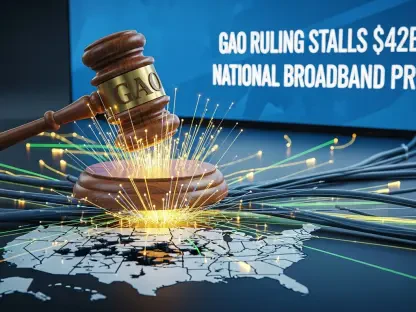Imagine a nation racing to secure its spot as a technological leader in Southeast Asia, with 5G infrastructure at the heart of this ambition, and in Malaysia, Digital Nasional Berhad (DNB), the state-backed wholesale 5G network operator, stands at a critical juncture. With significant financial investments pouring in and a new competitor shaking up the market, the stakes couldn’t be higher. This roundup dives into diverse perspectives from industry stakeholders, analysts, and regulatory insights to unpack DNB’s evolving role. The purpose is to explore how financial support, emerging competition, and policy shifts are shaping Malaysia’s 5G landscape, offering a comprehensive view of the opportunities and hurdles ahead.
Financial Reinforcement and Stakeholder Confidence
Breaking Down the Capital Injection
A major talking point among industry watchers is the recent MYR350 million investment into DNB by key telecommunications players CelcomDigi, Maxis, and YTL Power International. Each company contributed approximately MYR116.67 million, pushing their collective stake past the MYR1 billion mark. Many industry voices highlight this as a crucial lifeline, emphasizing that such funding ensures DNB can sustain its operations and expand 5G coverage across urban and rural areas alike.
However, not all opinions align on the long-term impact. Some financial analysts caution that while this injection signals strong stakeholder commitment, it may only be a temporary buffer. Rising operational costs and the need for continuous infrastructure upgrades could outpace current funding levels, potentially requiring further investments sooner than anticipated.
A contrasting view from within the telecom sector suggests optimism, with several leaders pointing out that this financial boost reflects a shared belief in DNB’s mission. The consensus among these stakeholders is that minimal strain on individual company balance sheets, as echoed in public statements, allows for sustained support without immediate fiscal pressure.
Assessing Risks Amid Growing Costs
Differing perspectives also emerge on the risks tied to this financial strategy. Certain industry observers warn that differing priorities among the investing telcos could create friction. If one player pushes for aggressive expansion while another prioritizes cost control, decision-making for DNB might stall, hampering its rollout plans.
On the flip side, some market analysts argue that the diversity of investors could be a strength, bringing varied expertise to the table. They suggest that collaborative governance models could mitigate potential conflicts, ensuring that funding aligns with national 5G goals rather than individual corporate agendas.
A third angle comes from regulatory commentators who stress the importance of transparency in how these funds are allocated. Their concern centers on whether DNB can balance operational demands with the expectations of its backers, urging clear accountability to prevent mismanagement or inefficiencies.
Competitive Pressures in the 5G Arena
U Mobile’s Independent Move Stirs Debate
The competitive landscape took a dramatic turn with U Mobile’s decision to launch a rival 5G network, a move sanctioned by the Malaysian Communications and Multimedia Commission (MCMC) in late 2024. Industry reactions vary widely, with some viewing U Mobile’s partnerships with global tech firms as a bold step that could invigorate market dynamics by introducing alternative technologies distinct from DNB’s current framework.
Others express concern over the potential fragmentation this creates. Several telecom analysts note that U Mobile’s exit from DNB, including the sale of its significant stake, might siphon off a portion of the customer base, directly impacting DNB’s revenue streams. This shift raises questions about the viability of a single wholesale model in a now-divided market.
A more neutral stance from market observers suggests that while competition poses risks, it could also drive innovation. They argue that having multiple players might push DNB to enhance service quality and pricing structures, ultimately benefiting consumers who stand to gain from a more dynamic 5G ecosystem.
Dual-Network Model: Boon or Bane?
Malaysia’s transition to a dual-network 5G framework, solidified by DNB achieving substantial coverage milestones, has sparked a spectrum of opinions. Some regional experts draw parallels to global markets where multiple operators coexist, arguing that competition often leads to better service reliability and faster technological advancements, which Malaysia could replicate.
However, a dissenting view among local industry players highlights the risk of market saturation, especially in densely populated urban centers. They worry that overlapping services might lead to redundant infrastructure investments, potentially neglecting rural areas where connectivity gaps remain a pressing issue.
Regulatory perspectives add another layer, emphasizing the need for balanced oversight to ensure that neither DNB nor its competitor overlooks underserved regions. Many in this camp advocate for policies that incentivize equitable coverage, suggesting that without such measures, the dual-network model might exacerbate existing digital divides.
Policy Shifts and Ownership Transitions
Government’s Divestment Plan Under Scrutiny
The Ministry of Finance’s intention to divest its substantial stake in DNB by late 2025 has generated significant discussion among policy analysts and industry leaders. A common viewpoint is that transferring control to private telcos could streamline decision-making, allowing DNB to operate with greater agility in a competitive environment.
Yet, there’s apprehension from some quarters about the implications of full privatization. Certain commentators argue that private ownership might shift DNB’s focus toward profit over public interest, potentially sidelining national goals like universal 5G access if they prove less lucrative.
A balanced perspective from economic advisors suggests that the success of this transition hinges on the terms of divestment. They recommend structured agreements that safeguard DNB’s original mission while allowing private entities the flexibility to innovate, pointing to similar telecom transitions in other nations as potential models for Malaysia.
Implications for DNB’s Strategic Direction
Beyond ownership, the broader policy shift toward a competitive 5G framework continues to divide opinions. Some stakeholders see the government’s pivot as a pragmatic acknowledgment of market realities, believing that stepping back from direct control could foster a more sustainable telecom sector driven by private investment.
Conversely, a segment of industry critics warns that reduced government involvement might expose DNB to market volatility. They argue that without a strong public anchor, strategic missteps by private owners could undermine Malaysia’s 5G ambitions, especially if short-term gains are prioritized over long-term infrastructure development.
A final viewpoint from regulatory thinkers underscores the importance of ongoing policy evolution. They advocate for continuous dialogue between government bodies, telcos, and DNB to ensure that ownership changes align with national interests, proposing regular reviews to adapt to unforeseen challenges in this rapidly shifting landscape.
Key Takeaways from Diverse Voices
Reflecting on the myriad insights gathered, it’s evident that DNB’s path forward is shaped by robust financial backing, with over MYR1 billion invested by major telcos, signaling strong confidence in its role. At the same time, U Mobile’s emergence as a competitor introduced a new layer of complexity, with opinions split on whether this rivalry will spur innovation or fragment the market. Policy shifts, particularly the planned privatization, also drew varied reactions, balancing optimism for efficiency against concerns over mission drift.
Looking ahead, actionable steps emerged from this discourse. Telcos might consider forming strategic alliances to support DNB while pursuing individual goals, ensuring a cohesive approach to 5G expansion. Regulators could focus on crafting frameworks that promote fair competition without neglecting rural connectivity, perhaps by incentivizing shared infrastructure in less profitable areas. For those keen to stay informed, tracking DNB’s funding cycles and market share dynamics offers a window into Malaysia’s evolving telecom narrative, providing critical insights for navigating future developments.









